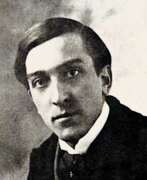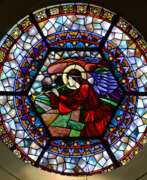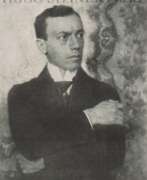Scenographers Symbolism


Boris Izraelievich Anisfeld (Russian: Борис Израилевич Анисфельд) was a Russian-American painter, set designer, illustrator, and educator, celebrated for his vivid use of color and imaginative scenery. Born in Bessarabia, Russian Empire, in 1878, Anisfeld's artistic journey led him from the Odessa School of Art to the Imperial Academy of Arts in Saint Petersburg, where he absorbed the influences of prominent artists like Ilya Repin and Igor Grabar. His distinct style caught the attention of Sergei Diaghilev, leading to his work with the Ballet Russe before World War I.
Anisfeld's contributions to art extend beyond his canvas, as his theater designs for Diaghilev's Ballets Russes and collaborations with notable figures like Michel Fokine and Anna Pavlova showcased his ability to blend fantasy with performance. His work with the Ballets Russes, including designing the production of "Sadko" and executing the visions of other celebrated artists for stage sets, marked a significant period in his career before he immigrated to the United States in 1917.
In America, Anisfeld continued his legacy, taking on roles such as a teacher at the Art Institute of Chicago and contributing to the cultural landscape through his stage designs and paintings. His work is recognized for its innovative approach to color and form, bridging the realms of painting and theater design to create immersive, emotionally resonant artworks. Anisfeld passed away in 1973, leaving behind a body of work that continues to inspire and captivate audiences.
For collectors and experts in art and antiques, Anisfeld's work represents a fusion of Russian and American art traditions, enriched by his imaginative approach and vibrant palette. His contributions to the development of modern art and theater design underscore the enduring relevance of his creative vision.
To stay updated on exhibitions, sales, and auctions related to Boris Israelievich Anisfeld, sign up for updates. This subscription will ensure you're informed about new opportunities to explore and acquire works by this influential artist.
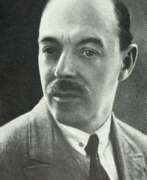

Anatoly Afanasyevich Arapov (Russian: Анатолий Афанасьевич Арапаов) was a Russian and Soviet artist, born in St. Petersburg in 1876 and passing away in Moscow in 1949. His artistic journey began after graduating from high school in 1892, leading him to study at the Moscow Boundary Institute where he initially acquired artistic skills. Arapov's dedication to art became undeniable, prompting him to enroll in the Moscow School of Painting, Sculpture and Architecture in 1897, where he was deeply involved in applied art, book design, and theater.
Arapov's early works, particularly around 1900 and 1910, were influenced by Symbolism, but he transitioned through a phase of Constructivism in the 1920s before dedicating himself to Socialist Realism from the 1930s onward. His versatile talent spanned across painting, graphic arts, and set design, making significant contributions to theater and film. Notably, he designed plays for leading theaters across major Russian cities and worked on popular films in the 1920s and 1930s.
His oeuvre includes portraits, still lifes, and landscapes, featuring views of ancient parks and Russian architecture. Arapov's works are celebrated for their stylistic diversity, capturing the essence of Symbolism, Constructivism, and Socialist Realism. His contributions are recognized in museum collections, including the State Tretyakov Gallery and the Saratov State Art Museum named after Radishchev, among others.
For collectors and art experts, Arapov's works offer a glimpse into the evolving art styles of early to mid-20th century Russia. To stay informed on sales and auction events featuring Anatoly Afanasyevich Arapov's art, signing up for updates can provide exclusive access to new discoveries and opportunities to acquire pieces by this multifaceted artist.
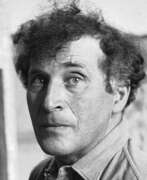

Marc Chagall (Russian: Марк Заха́рович Шага́л), born Moishe Shagal in 1887 near Vitebsk, Belarus (then part of the Russian Empire), was a Belarusian and French artist celebrated for his pivotal role in the avant-garde movement and his unique integration of Eastern European Jewish culture into modern art. His contributions spanned several artistic formats including painting, stained glass, stage sets, ceramics, tapestries, and fine art prints. Chagall's early modernist tendencies were enriched by his experiences across Saint Petersburg, Paris, and Berlin before World War I, leading to a distinctive style that melded Cubism, Symbolism, and Fauvism with his Jewish heritage.
Chagall's work is recognized for its emotional depth, often exploring themes of love, memory, and Jewish folklore through vibrant colors and dreamlike imagery. Notably, art critic Robert Hughes described him as "the quintessential Jewish artist of the twentieth century," a sentiment echoed by art historian Michael J. Lewis who regarded Chagall as a significant figure within European modernism and as the world's preeminent Jewish artist of his time.
Among Chagall's famed contributions are his stained-glass windows for the cathedrals of Reims and Metz, the UN, and the Jerusalem Windows in Israel. His monumental paintings include parts of the ceiling of the Paris Opéra and works that explore biblical themes, a hallmark of his oeuvre that underscores his enduring engagement with spiritual and religious motifs.
For art collectors and antiques experts, Chagall's works are notable not only for their artistic innovation but also for their rich cultural and historical significance. His art is housed in many prestigious museums worldwide, including the Marc Chagall National Museum in Nice, France, which focuses on his works inspired by religion and houses the series of paintings illustrating the biblical message.
For those interested in exploring Chagall's legacy and the vibrant intersection of culture, art, and history his work represents, signing up for updates on new product sales and auction events related to Marc Chagall can provide invaluable insights and opportunities. This is an invitation to engage more deeply with the world of art and culture that Chagall so uniquely encapsulated in his work.
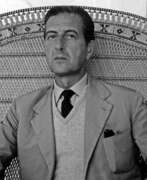

Fabrizio Clerici was an Italian painter, draftsman, illustrator, scenographer and architect.
Clerici earned a degree in architecture and was greatly influenced by antiquities, Renaissance and Baroque painting and architecture. In 1943, Clerici held his first solo exhibition at the Galleria dell'Arte Cairola in Milan, featuring drawings, watercolors, lithographs and etchings. His first book illustrations belong to the same period.
In 1947, Clerici began a prolific career in theater, ballet and opera with his debut as a stage designer in a production of George Bernard Shaw's play Mrs. Warren's Profession. The following year he participated for the first time in the Venice Biennale. There he met Salvador Dalí and created the sets and costumes for Igor Stravinsky's Orpheus, which was performed at the La Fenice Theater. In 1949 he created large-scale architectural fantasy paintings.
The further life of the multifaceted artist Fabrizio Clerici was full of work in a variety of fields of art, creative successes and exhibitions. His work has been exhibited in many museums in the United States, including MoMA and the Guggenheim Museum, as well as in France, such as the Pompidou Center.
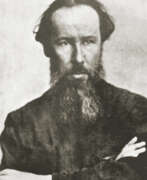

Vladimir Andreyevich Favorsky (Russian: Владимир Андреевич Фаворский) was a distinguished Russian artist and educator, renowned for his profound contributions to the realms of printmaking, illustration, and theory of art. Born into a milieu rich in culture and intellectual pursuit, Favorsky's work transcended the conventional boundaries of art, integrating elements of sculpture, painting, and graphic design, thereby redefining the aesthetic parameters of his time.
Favorsky's artistic philosophy was grounded in the belief that art should be a reflection of reality, yet imbued with the artist's personal vision and inner world. This approach led him to explore various mediums, yet he is most celebrated for his woodcuts and book illustrations. His ability to blend classical techniques with innovative narratives made his works timeless, appealing to collectors and art enthusiasts alike. Favorsky's contributions were not confined to his own creations; as a revered educator at the Moscow Printing Institute, he influenced generations of artists, instilling in them a deep appreciation for the cultural and historical significance of art.
Among his notable works, Favorsky's illustrations for classics of Russian literature stand out, capturing the essence of the narratives with striking visual imagery. While specific pieces in museums or galleries could not be verified without current research, his influence permeates the Russian art scene, with his works held in high esteem by collectors around the globe.
For collectors and experts in art and antiques, Favorsky's oeuvre represents a bridge between traditional and modern artistic expressions, offering a rich tapestry of themes and techniques to explore. His legacy continues to inspire, serving as a testament to the enduring power of artistic innovation and vision.
For enthusiasts eager to delve deeper into Favorsky's world, we invite you to sign up for updates. This subscription ensures you're the first to know about new product sales and auction events related to Vladimir Andreyevich Favorsky, without overwhelming your inbox. Embrace the opportunity to enhance your collection with pieces from a master of Russian art and culture.
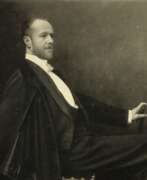

Fernand Khnopff, full name Fernand-Edmond-Jean-Marie Khnopff, was a Belgian Symbolist painter, graphic artist, sculptor and art historian.
Born into a wealthy family, Fernand attended the Royal Academy of Fine Arts in Brussels, where he studied painting with Xavier Mellerie. Throughout his years at the academy, Khnopff spent summers in Paris studying art, and at the 1878 World's Fair he saw the works of Pre-Raphaelite Edward Burne-Jones and Symbolist Gustave Moreau, which had a decisive influence on his work.
In the early 1880s Khnopff began to exhibit his Symbolist works, often inspired by literary works, particularly by Gustave Flaubert. His paintings combined precise realism with an ethereal fairy-tale atmosphere, and he also painted portraits.
In 1883 Khnopff co-founded Les Vingt, a group of Belgian avant-garde artists. From the early 1990s, he collaborated regularly with the Brussels opera house Royal de la Monnaie, designing costumes and sets for many productions. He also designed the interiors of Brussels' landmark buildings: the Maison Stoclet and the Hôtel de Ville in Saint-Gilles.
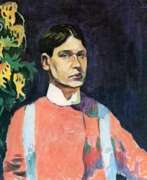

Aristarkh Vasilyevich Lentulov (Russian: Аристарх Васильевич Лентулов) was a prominent figure in Russian avant-garde art, celebrated for his distinctive use of color and innovative approach to Cubism. Born in Nizhneye Lomovo, Penza oblast, Russia, in 1882, Lentulov's early years were spent in a religious family, setting a foundation that would influence his rich and vibrant artistic style. His education at the art institutes in Penza and Kiev, followed by his studies under Dmitry Kardovsky in St. Petersburg, prepared Lentulov for a groundbreaking artistic career.
Lentulov's artistic journey took a significant turn when he moved to Paris in the winter of 1911. There, he was exposed to the works of leading French Cubists at the Académie de la Palette, including Henri Le Fauconnier. This period marked Lentulov's deep dive into Cubism and Orphism, influenced by his interactions with avant-garde artists such as Jean Metzinger, Albert Gleizes, and Fernand Léger. Upon his return to Russia, he became one of the founders of the Jack of Diamonds, a group that exhibited artists with "leftist tendencies" and embraced foreign, mostly French Cubists.
Lentulov's style uniquely combined the spatial concepts of Cubism with the vibrant colors of Fauvism, drawing on Russian folk art to create compositions that were both innovative and deeply rooted in Russian culture. His works, characterized by their luminous color and dynamic composition, played a significant role in the development of Russian Futurism and Cubo-Futurism. Notably, his involvement in theatrical projects, including set designs for the Kamerny Theatre and the Bolshoi Theatre, highlighted his versatility and creative genius.
Aristarkh Lentulov's legacy is preserved in his contributions to the avant-garde movement, and his works continue to be celebrated for their bold experimentation and vibrant expression. His paintings, such as "Saint Basil's Cathedral" and "The Belfry of Ivan the Great," are held in high esteem, showcasing his ability to capture the essence of Russian architecture and culture through a modernist lens.
Art enthusiasts and collectors recognize Lentulov as a pivotal figure in the evolution of modern Russian art. His innovative techniques and bold use of color have cemented his place in art history as a master of Russian avant-garde.
For updates on exhibitions and auction events featuring Aristarkh Vasilyevich Lentulov's work, sign up for our newsletter. Stay informed about the latest sales and opportunities to add a piece of Russian avant-garde history to your collection.
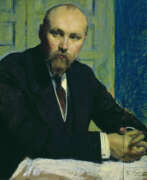

Nikolai Konstantinovich Roerich (Russian: Никола́й Константи́нович Ре́рих) was a distinguished Russian artist, writer, archaeologist, and philosopher, renowned for his profound contributions to culture and art. His multifaceted career spanned various disciplines, but it was his exceptional talent in painting that immortalized his name among the greats. Roerich's art is celebrated for its mystical and symbolic themes, often drawing inspiration from Russian folklore, religion, and his own spiritual quests. His dedication to cultural preservation and peace through art led to the establishment of the Roerich Pact, a treaty advocating for the protection of cultural heritage.
Roerich's paintings are characterized by vibrant colors and intricate details, capturing the ethereal beauty of landscapes and mythical scenes. His works, such as "Madonna Laboris" and the series "Sancta," are revered for their spiritual depth and artistic excellence. These masterpieces can be found in prestigious museums and galleries worldwide, serving as testaments to Roerich's enduring legacy in the art world. His commitment to integrating spiritual and cultural dimensions in his art has made him a seminal figure for collectors and experts in art and antiques.
Roerich's influence extends beyond his paintings; his philosophical writings and cultural initiatives have also left a significant mark on the fields of art and heritage preservation. As enthusiasts of art and antiquities continue to explore Roerich's rich legacy, there is a growing appreciation for his vision of unity and harmony through cultural expression. For those captivated by Roerich's remarkable life and works, signing up for updates is an invaluable opportunity to stay informed about new product sales and auction events dedicated to his art. This subscription is a gateway to exclusive insights and offerings that celebrate the legacy of Nikolai Konstantinovich Roerich, ensuring enthusiasts remain connected to the evolving exploration of his profound contributions.
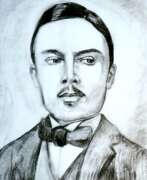

Nikolai Nikolaevich Sapunov (Russian: Николай Николаевич Сапунов) was a distinguished painter of the Russian Empire, celebrated for his contributions to the Symbolist movement. Born in Moscow in 1880, Sapunov honed his artistic skills at the Moscow School of Painting, Sculpture and Architecture under the guidance of notable figures like Isaac Levitan, and at the Imperial Academy of Arts in St. Petersburg. His artistic journey led him to design sets for the Bolshoi Theatre, the Moscow Art Theatre, and to collaborate with innovative directors like Meyerhold. Sapunov's still lifes, particularly those featuring flowers and china, stand among his best-known works. Tragically, his life was cut short at the age of 32 in a boating accident in Terioki, Finland, now known as Zelenogorsk.
Sapunov's legacy is anchored in his role as a key set designer in Russian theater, and his affiliation with influential art associations like the Moscow Association of Artists and the Blue Rose group. His art, characterized by emotional depth and a unique color palette, delves into themes of theatricality, festivities, and the ethereal world of still lifes, making him one of the early 20th century's most original Russian artists. A notable piece, "Peonies" (1907), exemplifies his mastery of color and form, earning a place in prestigious collections and exhibitions.
For collectors and art enthusiasts keen on exploring Sapunov's visionary world, his contributions to Russian Symbolism and his innovative set designs mark him as a figure of historical and aesthetic significance. His works not only captivate viewers with their beauty but also serve as a gateway to the cultural and artistic dialogues of his time. Rediscovered in recent years, Sapunov's oeuvre continues to enchant and inspire, embodying the spirit of an era marked by experimentation and the search for new artistic expressions.
To stay updated on new discoveries and auction events featuring Nikolai Nikolaevich Sapunov's art, sign up for our newsletter. This subscription ensures that you're always informed about the latest sales and insights into the work of this remarkable artist.


Gyorgy Stefula is a German painter, illustrator, costume designer and stage designer.
Stefula studied at the Academy of Fine Arts in Hamburg and the Higher School of Painting in Altona, and married Dorothea Hüter, who became his creative collaborator. After World War II, he participated in numerous exhibitions in Germany and abroad. Together with Dorothea, they frequently exhibited their work and collaborated on several projects, including stage and costume design for the National Opera in Munich.
Among Stefula's unique works in the spirit of Henri Rousseau or Pittura Metafisica are imaginary, fantastical landscapes and incredible portraits, magical still lifes and animals; they are full of symbolism and mythological references.
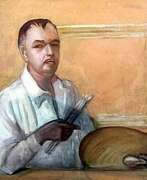

Sergey Yurievich Sudeikin (Russian: Сергей Юрьевич Судейкин), also known as Serge Soudeikine, was a Russian artist and set-designer renowned for his vivid contributions to the world of art and theater. Born on March 19, 1882, in Smolensk, Russia, and passing away on August 12, 1946, in Nyack, New York, Sudeikin's career was a testament to his versatile talent and innovative vision. He was closely associated with prestigious institutions such as the Ballets Russes and the Metropolitan Opera, showcasing his unique ability to blend artistic and theatrical design.
Sudeikin's journey in the arts began at the Moscow School of Painting, Sculpture and Architecture, where he was notably banned for his bold, "obscene drawings". This rebellious start led him to join the Mir Iskusstva (World of Art) movement, solidifying his place among Russia's avant-garde artists. His circle included significant figures like poet Mikhail Kuzmin and impresario Serge Diaghilev, highlighting his integral role in Russia's cultural scene before emigrating to the West.
Among Sudeikin's notable works are his set and costume designs for Diaghilev's production of "La tragédie de Salomé" and his collaboration on "The Rite of Spring". After moving to the United States, he continued to leave his mark on the theater world, with works like the set design for the original Broadway production of "Porgy and Bess". Sudeikin's style is recognized for its theatricality, vivid color use, and often incorporated themes of irony and tragedy, deeply influencing the visual arts and theater design of the 20th century.
His artwork, including famous pieces like "Carousel", "Venetian masquerade", and "Portrait of Nina Shik", can be found in galleries and private collections worldwide, highlighting his enduring appeal. Despite facing challenges in gaining widespread recognition during his lifetime, Sudeikin's contributions to art and theater have solidified his legacy as a pioneering artist and designer.
Collectors and experts in art and antiques continue to celebrate Sergey Yurievich Sudeikin's work for its innovative approach and historical significance. To stay updated on sales and auction events related to Sudeikin's work, signing up for updates is highly recommended. This ensures that enthusiasts and collectors alike do not miss out on the opportunity to own a piece of this remarkable artist's legacy.
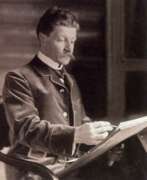

Mikhail Aleksandrovich Vrubel (Russian: Михаил Александрович Врубель), a distinguished Russian artist, was renowned for his profound contributions to the world of art, spanning painting, sculpture, and the decorative arts. Born in Omsk in 1856, Vrubel's unique approach to art, characterized by its intricate detail and vibrant use of color, has captivated art collectors and experts alike. His works are celebrated for their innovative blend of realism and Symbolism, setting him apart in the pantheon of great artists.
Vrubel's oeuvre is notable for its fantastical themes, often drawing on mythological and fairy tale motifs to create deeply atmospheric and emotionally charged pieces. Among his most famous works are "The Demon Seated" and "The Swan Princess," which reside in prestigious Russian museums like the Tretyakov Gallery and the Russian Museum. These pieces exemplify his skill in using color and form to evoke a haunting, otherworldly beauty.
His influence extends beyond his canvas; Vrubel's contributions to theater design and decorative art have left a lasting legacy on the Russian cultural landscape. For art collectors and enthusiasts, Vrubel's work offers a window into the soul of Russian Symbolism, making his pieces highly sought after for their beauty and historical significance.
We invite you to sign up for updates on sales of art pieces and auction events related to Mikhail Aleksandrovich Vrubel. This is a unique opportunity to deepen your understanding of Russian art and to enhance your collection with works from one of its most illustrious figures. Join us in exploring the enduring legacy of Vrubel's artistry.


Konstantin Fyodorovich Yuon (Russian: Константи́н Фёдорович Юо́н) was a distinguished Russian artist and painter, celebrated for his multifaceted contributions to the world of art. Born in Moscow, Yuon's work spans painting, stage design, and teaching, making significant impacts across these fields. His artistry is renowned for blending traditional Russian motifs with innovative techniques, illustrating the rich tapestry of Russian culture and history.
Yuon's masterpieces are characterized by their vibrant use of color and light, capturing the essence of Russian landscapes and urban scenes with a unique lyrical quality. His notable works, such as "New Planet" and "The March Sun," showcase his ability to transcend the ordinary, offering viewers a glimpse into the ethereal beauty of everyday life. These pieces not only highlight his technical prowess but also his profound understanding of the emotional and cultural significance of his subjects.
Throughout his career, Yuon's influence extended beyond the canvas, as he nurtured the next generation of artists through his teaching. His dedication to the arts was recognized with prestigious awards, affirming his status as a pillar of the Russian art community. Today, his works are preserved in major museums and galleries, serving as a testament to his enduring legacy in the fields of painting and cultural heritage.
For collectors and experts in art and antiques, the legacy of Konstantin Fyodorovich Yuon offers a fascinating exploration into the evolution of Russian art. His works not only represent significant artistic achievements but also embody the cultural and historical narratives of their time. To stay informed on new product sales and auction events featuring Yuon's work, we invite you to sign up for updates. This subscription will ensure you're always in the loop on opportunities to own a piece of Russian art history.
